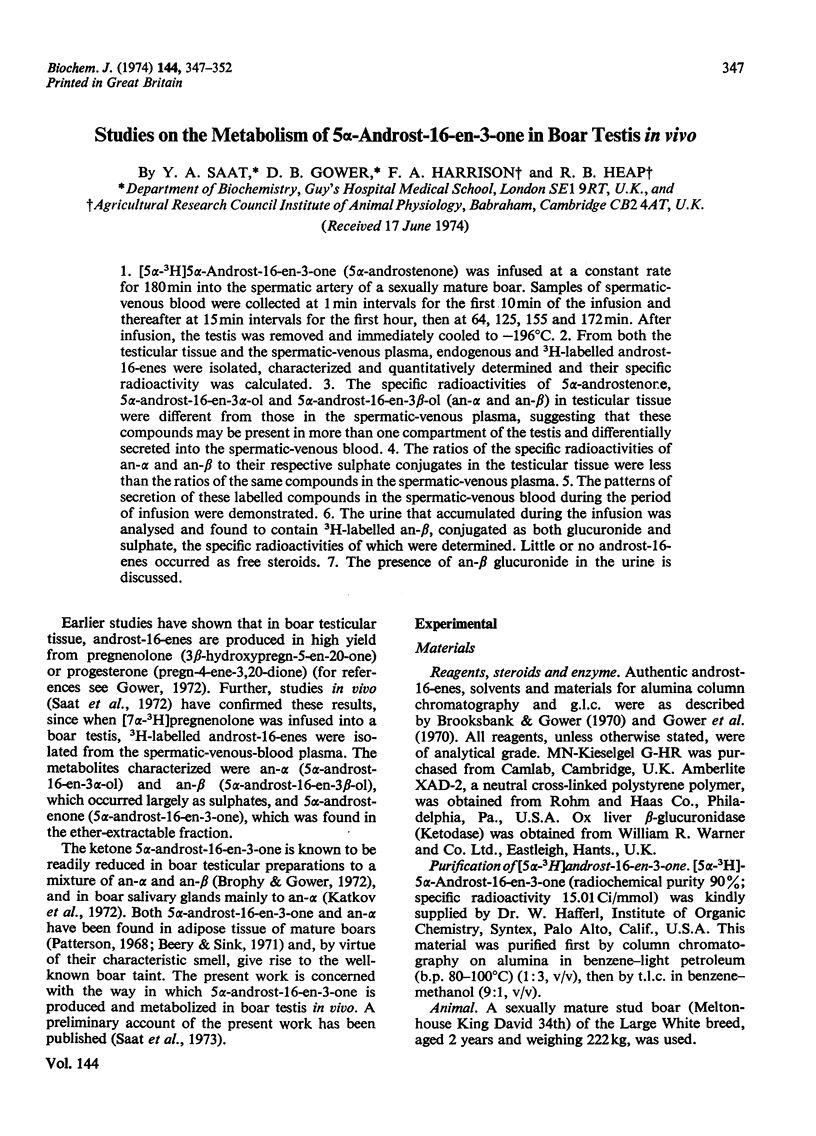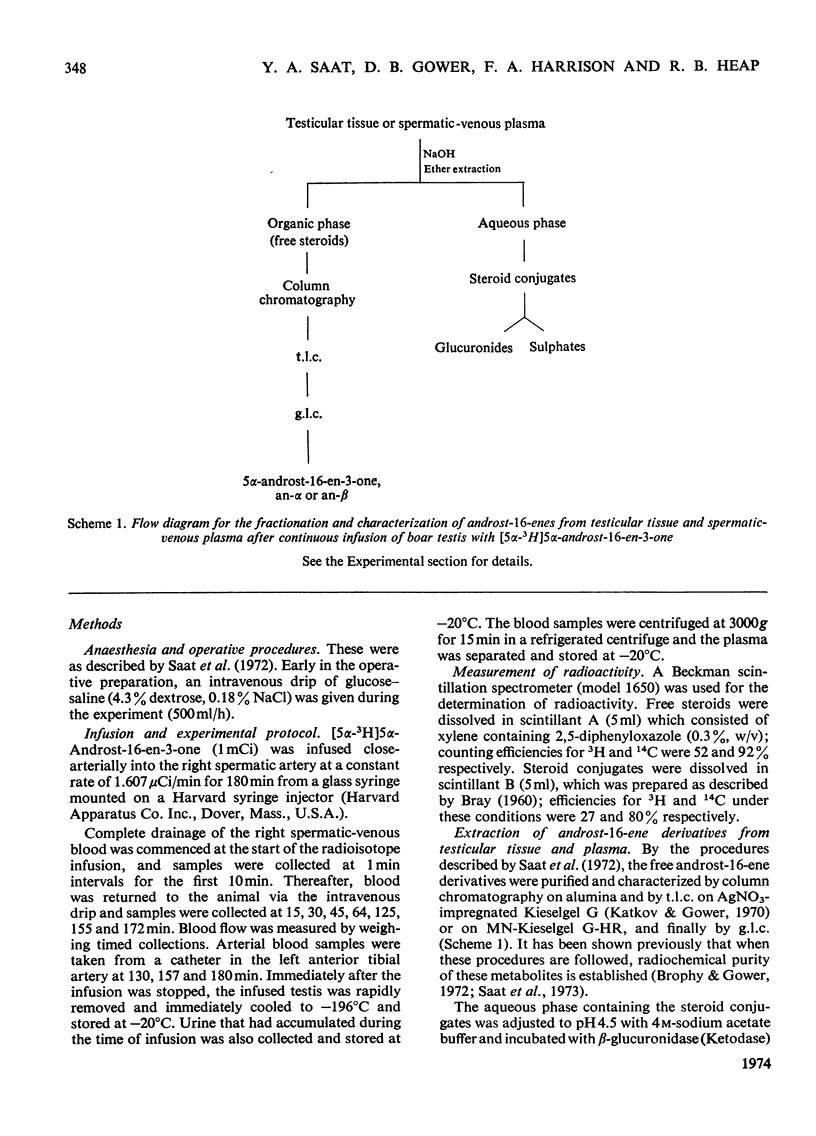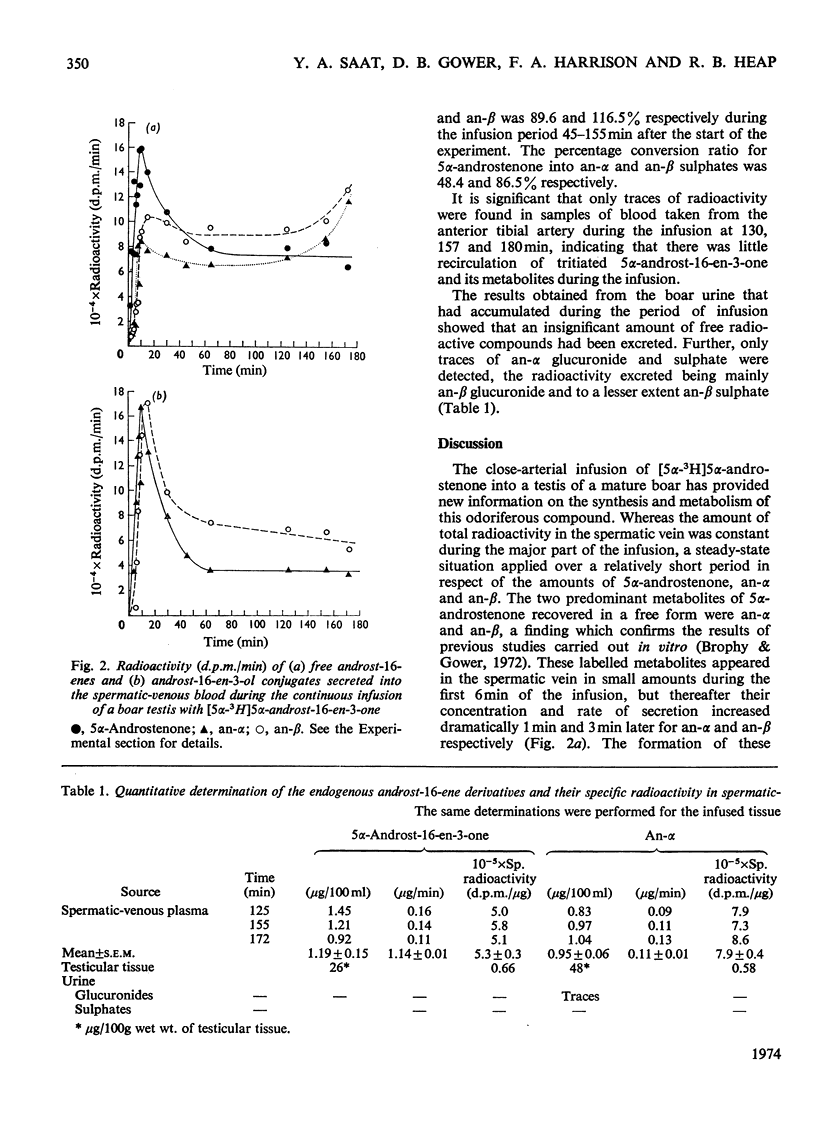Abstract
1. [5α-3H]5α-Androst-16-en-3-one (5α-androstenone) was infused at a constant rate for 180min into the spermatic artery of a sexually mature boar. Samples of spermatic-venous blood were collected at 1min intervals for the first 10min of the infusion and thereafter at 15min intervals for the first hour, then at 64, 125, 155 and 172min. After infusion, the testis was removed and immediately cooled to −196°C. 2. From both the testicular tissue and the spermatic-venous plasma, endogenous and 3H-labelled androst-16-enes were isolated, characterized and quantitatively determined and their specific radioactivity was calculated. 3. The specific radioactivities of 5α-androstenore, 5α-androst-16-en-3α-ol and 5α-androst-16-en-3β-ol (an-α and an-β) in testicular tissue were different from those in the spermatic-venous plasma, suggesting that these compounds may be present in more than one compartment of the testis and differentially secreted into the spermatic-venous blood. 4. The ratios of the specific radioactivities of an-α and an-β to their respective sulphate conjugates in the testicular tissue were less than the ratios of the same compounds in the spermatic-venous plasma. 5. The patterns of secretion of these labelled compounds in the spermatic-venous blood during the period of infusion were demonstrated. 6. The urine that accumulated during the infusion was analysed and found to contain 3H-labelled an-β, conjugated as both glucuronide and sulphate, the specific radioactivities of which were determined. Little or no androst-16-enes occurred as free steroids. 7. The presence of an-β glucuronide in the urine is discussed.
Full text
PDF





Selected References
These references are in PubMed. This may not be the complete list of references from this article.
- AAKVAAG A., HAGEN A. A., EIK-NES K. B. BIOSYNTHESIS IN VIVO OF TESTOSTERONE AND DELTA-4-ANDROSTENEDIONE FROM DEHYDROEPIANDROSTERONE-SODIUM SULFATE BY THE CANINE TESTIS AND OVARY. Biochim Biophys Acta. 1964 Jun 8;86:622–627. doi: 10.1016/0304-4165(64)90102-3. [DOI] [PubMed] [Google Scholar]
- BURSTEIN S., DORFMAN R. I. Determination of mammalian steroid sulfatase with 7 alpha-H3-3beta-hydroxyandrost-5-en-17-one sulfate. J Biol Chem. 1963 May;238:1656–1660. [PubMed] [Google Scholar]
- BURSTEIN S., LIEBERMAN S. Hydrolysis of ketosteroid hydrogen sulfates by solvolysis procedures. J Biol Chem. 1958 Aug;233(2):331–335. [PubMed] [Google Scholar]
- Baulieu E. E., Fabre-Jung I., Huis in't Veld L. G. Dehydroepinadrosterone sulfate: a secretory product of the boar testis. Endocrinology. 1967 Jul;81(1):34–38. doi: 10.1210/endo-81-1-34. [DOI] [PubMed] [Google Scholar]
- Beery K. E., Sink J. D. Isolation and identification of 3 -hydroxy-5 -androst-16-ene and 5 -androst-16-en-3-one from procine adipose tissue. J Endocrinol. 1971 Sep;51(1):223–224. doi: 10.1677/joe.0.0510223. [DOI] [PubMed] [Google Scholar]
- Bell J. B., Vinson G. P., Lacy D. Studies on the structure and function of the mammalian testis. 3. In vitro steroidogenesis by the seminiferous tubules of rat testis. Proc R Soc Lond B Biol Sci. 1971 Jan 12;176(1045):433–443. doi: 10.1098/rspb.1971.0007. [DOI] [PubMed] [Google Scholar]
- Brooksbank B. W., Gower D. B. The estimation of 3 alpha-hydroxy-5 alpha-androst-16-ene and other C19-delta 16-steroids in urine by gas-liquid chromatography. Acta Endocrinol (Copenh) 1970 Jan;63(1):79–90. doi: 10.1530/acta.0.0630079. [DOI] [PubMed] [Google Scholar]
- Brooksbank B. W., Haslewood G. A. The estimation of androst-16-en-3alpha-ol in human urine. Partial synthesis of androstenol and of its beta-glucosiduronic acid. Biochem J. 1961 Sep;80(3):488–496. doi: 10.1042/bj0800488. [DOI] [PMC free article] [PubMed] [Google Scholar]
- Brophy P. J., Gower B. D. 16-unsaturated C 19 3-oxo steroids as metabolic intermediates in boar testis. Biochem J. 1972 Jul;128(4):945–952. doi: 10.1042/bj1280945. [DOI] [PMC free article] [PubMed] [Google Scholar]
- Galena H. J., Terner C. Conversion of progesterone to androgens by non-flagellate germinal cells isolated from seminiferous tubules of rat testis. J Endocrinol. 1974 Feb;60(2):269–276. doi: 10.1677/joe.0.0600269. [DOI] [PubMed] [Google Scholar]
- Gower D. B. 16-Unsaturated C 19 steroids. A review of their chemistry, biochemistry and possible physiological role. J Steroid Biochem. 1972 Jan;3(1):45–103. doi: 10.1016/0022-4731(72)90011-8. [DOI] [PubMed] [Google Scholar]
- Gower D. B., Harrison F. A., Heap R. B. The identification of C19-16-unsaturated steroids and estimation of 17-oxosteroids in boar spermativ vein plasma and urine. J Endocrinol. 1970 Jul;47(3):357–365. [PubMed] [Google Scholar]
- Inoue N., Sandberg A. A., Graham J. B., Slaunwhite W. R., Jr Studies on phenolic steroids in human subjects. 8. Metabolism of estriol-16 alpha-glucosiduronate. J Clin Invest. 1969 Feb;48(2):380–389. doi: 10.1172/JCI105995. [DOI] [PMC free article] [PubMed] [Google Scholar]
- Inoue N., Sandberg A. A., Graham J. B., Slaunwhite W. R., Jr Studies on phenolic steroids in human subjects. IX. Role of the intestine in the conjugation of estriol. J Clin Invest. 1969 Feb;48(2):390–396. doi: 10.1172/JCI105996. [DOI] [PMC free article] [PubMed] [Google Scholar]
- Katkov T., Booth W. D., Gower D. B. The metabolism of 16-androstenes in boar salivary glands. Biochim Biophys Acta. 1972 Aug 11;270(4):546–556. doi: 10.1016/0005-2760(72)90120-8. [DOI] [PubMed] [Google Scholar]
- Katkov T., Gower D. B. The biosynthesis of androst-16-enes in boar testis tissue. Biochem J. 1970 Apr;117(3):533–538. doi: 10.1042/bj1170533. [DOI] [PMC free article] [PubMed] [Google Scholar]
- Longcope C., Layne D. S., Tait J. F. Metabolic clearance rates and interconversions of estrone and 17beta-estradiol in normal males and females. J Clin Invest. 1968 Jan;47(1):93–106. doi: 10.1172/JCI105718. [DOI] [PMC free article] [PubMed] [Google Scholar]
- Osawa Y., Slaunwhite W. R., Jr Studies on phenolic steroids in human subjects. 13. A rapid assay of urinary estrogen conjugates in pregnancy. Steroids. 1970 Jan;15(1):73–88. doi: 10.1016/s0039-128x(70)80005-8. [DOI] [PubMed] [Google Scholar]
- ROY A. B. The synthesis and hydrolysis of sulfate esters. Adv Enzymol Relat Subj Biochem. 1960;22:205–235. doi: 10.1002/9780470122679.ch5. [DOI] [PubMed] [Google Scholar]
- SANDBERG A. A., SLAUNWHITE W. R., Jr STUDIES ON PHENOLIC STEROIDS IN HUMAN SUBJECTS. VII. METABOLIC FATE OF ESTRIOL AND ITS GLUCURONIDE. J Clin Invest. 1965 Apr;44:694–702. doi: 10.1172/JCI105181. [DOI] [PMC free article] [PubMed] [Google Scholar]
- Saat Y. A., Gower D. B., Harrison F. A., Heap R. B. Studies on the biosynthesis in vivo and excretion of 16-unsaturated C 19 steroids in the boar. Biochem J. 1972 Sep;129(3):657–663. doi: 10.1042/bj1290657. [DOI] [PMC free article] [PubMed] [Google Scholar]
- Wang D. Y., Bulbrook R. D., Sneddon A., Hamilton T. The metabolic clearance rates of dehydroepiandrosterone, testosterone and their sulphate esters in man, rat and rabbit. J Endocrinol. 1967 Jul;38(3):307–318. doi: 10.1677/joe.0.0380307. [DOI] [PubMed] [Google Scholar]
- van der Molen H. J., Eik-Nes K. B. Biosynthesis and secretion of steroids by the canine testis. Biochim Biophys Acta. 1971 Nov 5;248(2):343–362. doi: 10.1016/0005-2760(71)90023-3. [DOI] [PubMed] [Google Scholar]


